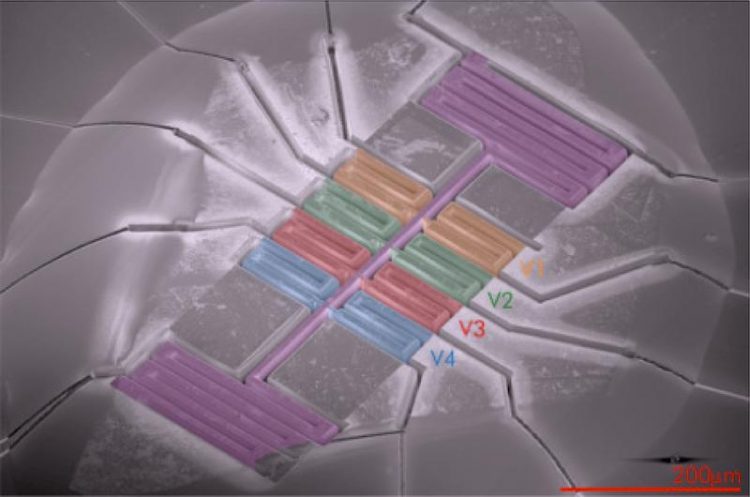Electron Rivers

One of the created “electron rivers”. The flow takes place along the purple channel, and is studied using instruments attached to the blue, red, green and gold-coloured parts. MPI CPfS
Although one might think that when there is an electric current in a metal, the electrons flow like water would in a pipe, that is actually not the case. Their motion is impeded because they bounce off the atoms that make up the metallic crystal, and the flow process is not nearly as interesting as the ones that we can see at play any time we sit next to a river.
For ‘electron rivers’ to exist, one needs to find extraordinary materials in which the collisions with the host atoms are thousands of times weaker than usual. Although this possibility, known as ‘electronic hydrodynamics’, was predicted theoretically over fifty years ago, it has taken until now to reach the new regime in a bulk material.
In Science Magazine (volume 351, 4th March 2016; see also the article “Perspectives” by J. Zaanen), three papers simultaneously reported experimental success. The groups of Philip Kim at Harvard and Andre Geim at Manchester worked on graphene, but the contribution from the Mackenzie and Moll groups from the Max Planck Institute for Chemical Physics of Solids Dresden was based on an oxide metal.
Our material of choice, PdCoO2, has an astonishingly high electrical conductivity, making it possible to look for hydrodynamic effects. To reveal their presence, we sculpted successively narrower channels, and studied how easily the electrons could flow through them.
By combining our results with a special theory that is able to model hydrodynamic effects, we were able to show that we had indeed created the long-predicted electron rivers. The research opens new frontiers in research into electron behavior in ultra-pure materials.
The richness seen in the flow of water might be observable in the flow of electrons, and some of this richness might one day also lead to the invention of new electronic devices. We hope to play a leading role in these developments.
The research at the Max Planck Institute for Chemical Physics of Solids (MPI CPfS) in Dresden aims to discover and understand new materials with unusual properties. In close cooperation, chemists and physicists (including chemists working on synthesis, experimentalists and theoreticians) use the most modern tools and methods to examine how the chemical composition and arrangement of atoms, as well as external forces, affect the magnetic, electronic and chemical properties of the compounds. New quantum materials, physical phenomena and materials for energy conversion are the result of this interdisciplinary collaboration.
The MPI CPfS (www.cpfs.mpg.de) is part of the Max Planck Society and was founded in 1995 in Dresden. It consists of around 280 employees, of which about 180 are scientists, including 70 doctoral students.
Media Contact
All latest news from the category: Materials Sciences
Materials management deals with the research, development, manufacturing and processing of raw and industrial materials. Key aspects here are biological and medical issues, which play an increasingly important role in this field.
innovations-report offers in-depth articles related to the development and application of materials and the structure and properties of new materials.
Newest articles

You are What You Eat—Stanford Study Links Fiber to Anti-Cancer Gene Modulation
The Fiber Gap: A Growing Concern in American Diets Fiber is well known to be an important part of a healthy diet, yet less than 10% of Americans eat the minimum recommended…

Trust Your Gut—RNA-Protein Discovery for Better Immunity
HIRI researchers uncover control mechanisms of polysaccharide utilization in Bacteroides thetaiotaomicron. Researchers at the Helmholtz Institute for RNA-based Infection Research (HIRI) and the Julius-Maximilians-Universität (JMU) in Würzburg have identified a…

ASXL1 Mutation: The Hidden Trigger Behind Blood Cancers and Inflammation
Scientists show how a mutated gene harms red and white blood cells. LA JOLLA, CA—Scientists at La Jolla Institute for Immunology (LJI) have discovered how a mutated gene kicks off…



